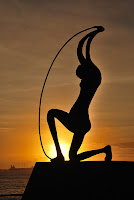“Soy América Latina un pueblo sin piernas
pero que camina.” (I’m Latin
America a people without legs yet walks.) (Latinoamérica, Calle 13).
 All of our discussions
in class from the beginning of the year were about how Latin America came to
be, their founding story. And for most of the countries and definitely Latin
America as a whole it’s hard to define exactly how they came to be or what
exactly makes up Latin America and makes their culture uniquely theirs. That’s
why I love this line so much. This is a people that while they don’t know their
background completely they keep moving forward.
All of our discussions
in class from the beginning of the year were about how Latin America came to
be, their founding story. And for most of the countries and definitely Latin
America as a whole it’s hard to define exactly how they came to be or what
exactly makes up Latin America and makes their culture uniquely theirs. That’s
why I love this line so much. This is a people that while they don’t know their
background completely they keep moving forward.  But I think that is
how they actually define themselves. Every day they define more and more who
and what Latin America is. Their culture is constantly changing and I think
that’s what solidifies them. They are able to keep walking through it all and not
get discouraged and give up, but keep making things their own. Latinoamérica is basically all about
stickin’ it to the man. They aren’t going to let anyone get in their way.
But I think that is
how they actually define themselves. Every day they define more and more who
and what Latin America is. Their culture is constantly changing and I think
that’s what solidifies them. They are able to keep walking through it all and not
get discouraged and give up, but keep making things their own. Latinoamérica is basically all about
stickin’ it to the man. They aren’t going to let anyone get in their way.
Recently in my
Doctrine and Covenants class we have been talking about the revelation that
came to President Spencer W. Kimball saying all worthy males could receive the
priesthood. (Don’t worry, this really does tie in with the topic). There is a
black guy in the class and he asked the teacher if he could take a few minutes
today in class and talk about it from his perspective since he felt it was his
duty. He basically said that while we have no idea where exactly this policy came
from to begin with, all he knows is that we have a prophet leading us today and
that the Church is true so nothing else matters. He said how he doesn’t worry
about it at all; it doesn’t even bother him. He accepts the past and keeps on
going. This is what Latin America does. They might not know where exactly they
came from, yet they keep on going; the past doesn’t hold them up or hinder
their progress. “Vamos caminando.”




























